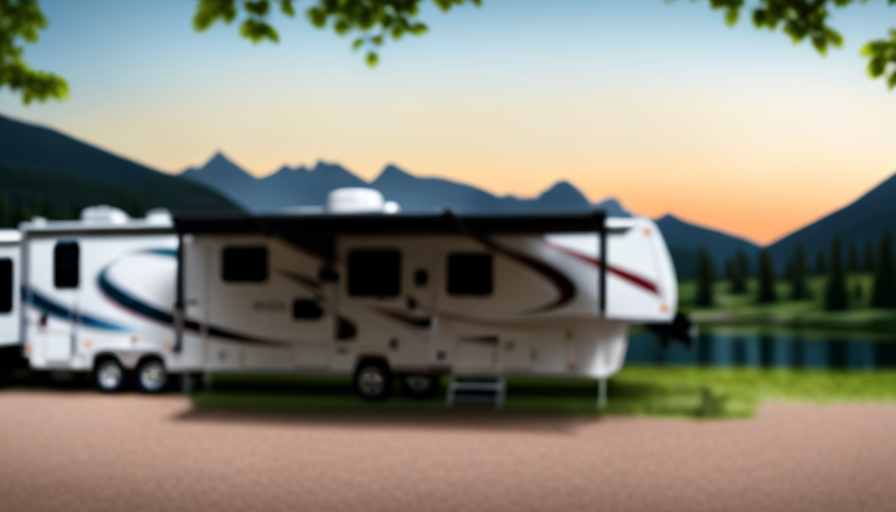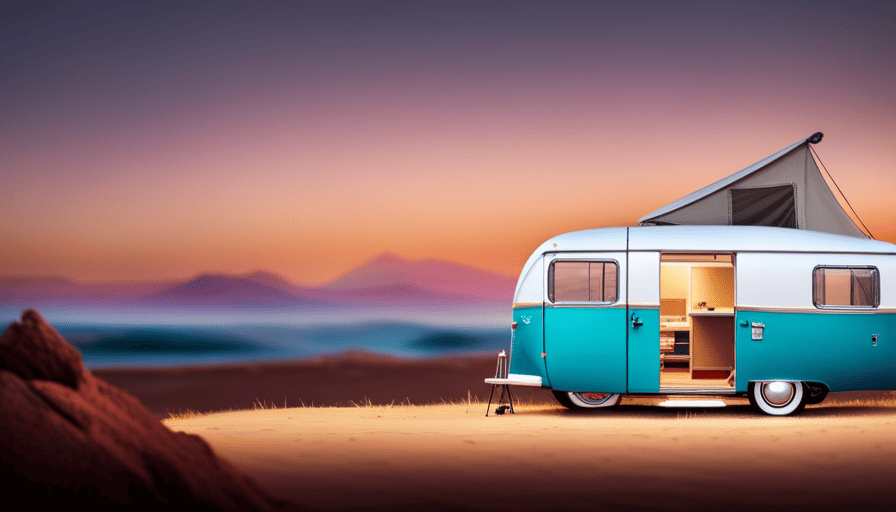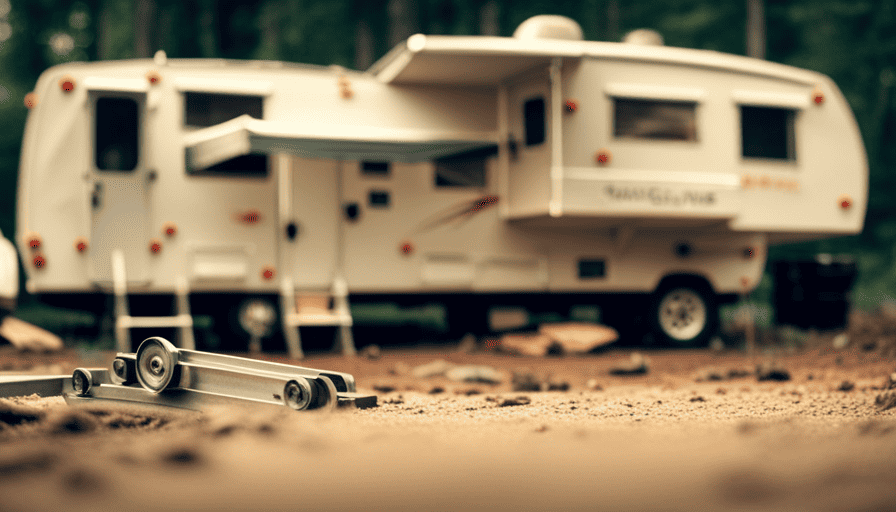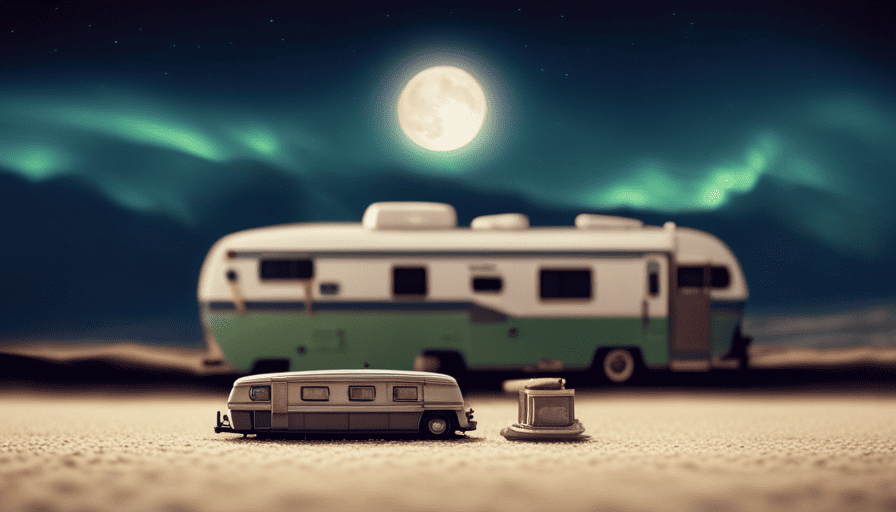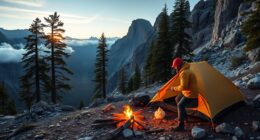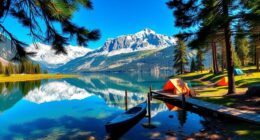Over 2 million Americans own a fifth wheel camper, proving just how popular these versatile and spacious RVs have become among adventure seekers and nature enthusiasts.
But what exactly is a fifth wheel camper? Well, let me break it down for you. A fifth wheel camper is a type of RV that is designed to be towed by a pickup truck with a special hitch. It gets its name from the unique hitching system, which is located in the bed of the truck and resembles a fifth wheel. This design allows for greater stability and maneuverability on the road, making it a favorite among experienced campers.
In this article, we will explore the definition and design of a fifth wheel camper, discuss the advantages and features to look for, and provide tips for a successful fifth wheel camping trip.
So, if you’re ready to embrace the freedom and adventure of fifth wheel camping, let’s dive in!
Key Takeaways
- Fifth wheel campers are designed to be towed by a pickup truck with a special hitch.
- They offer greater stability and maneuverability on the road compared to other types of campers.
- Regular maintenance is crucial for optimal performance of a fifth wheel camper.
- Important features to look for include bedroom and bathroom amenities, kitchen and dining facilities, and entertainment and technology options.
Definition and Design of a Fifth Wheel Camper
A fifth wheel camper is a type of recreational vehicle that combines the convenience of a motorhome with the towing capabilities of a trailer, making it a popular choice for adventurous travelers on the open road. These campers are designed to be towed by a pickup truck with a specialized hitch that connects to a fifth wheel coupling mounted in the bed of the truck. Fifth wheel campers are often praised for their spacious interiors and luxurious amenities, including fully equipped kitchens, comfortable living areas, and ample storage space. Additionally, many fifth wheel camper features include slide-out sections that expand the living space when parked, as well as advanced technology such as satellite TV and Wi-Fi connectivity. With their versatility and comfort, it’s no wonder that fifth wheel campers are a popular choice for those seeking a home away from home while exploring the great outdoors.
One of the main advantages of a fifth wheel camper is its spacious and comfortable interior. With extra headroom and multiple slide-outs, these campers can provide ample living space for families or groups of friends. Additionally, the elevated design of the fifth wheel allows for a more stable towing experience compared to traditional travel trailers.
However, there are also some drawbacks to consider. The larger size and weight of a fifth wheel camper can make maneuvering and parking more challenging. Additionally, the hitch setup requires a pickup truck with a compatible towing capacity, which may limit the options for travelers who prefer smaller vehicles.
To ensure the longevity and optimal performance of a fifth wheel camper, regular maintenance is crucial. This includes inspecting and lubricating the hitch mechanism, checking and maintaining the tires, and regularly servicing the brakes and suspension system.
Overall, a fifth wheel camper offers a unique combination of convenience and towing capabilities. In the subsequent section, we’ll explore the advantages of choosing a fifth wheel camper for your next adventure.
Advantages of a Fifth Wheel Camper
One major advantage of a fifth wheel camper is how spacious and comfortable it is compared to other types of campers. With their unique design, fifth wheel campers offer more living space and headroom, making them a popular choice for those who value comfort and roominess. The raised bedroom area over the truck bed provides extra vertical space, creating a more open and airy feel.
Additionally, the multiple slide-out sections available in many fifth wheel models further expand the living area, giving you plenty of room to relax and enjoy your time on the road.
Not only are fifth wheel campers spacious, but they also offer cost considerations and fuel efficiency. Due to their design, fifth wheel campers distribute weight more evenly between the truck and trailer, resulting in improved fuel efficiency compared to other types of campers. This can help you save on fuel costs during your travels, making it a more economical choice in the long run. Additionally, the cost of a fifth wheel camper is often lower than that of a motorhome or travel trailer, making it an attractive option for budget-conscious campers.
When considering a fifth wheel camper, there are several features to look for that can enhance your camping experience. Transitioning to the subsequent section about ‘features to look for in a fifth wheel camper’, it is important to consider factors such as towing capacity, hitch compatibility, and amenities such as kitchen appliances and entertainment systems.
Features to Look for in a Fifth Wheel Camper
When it comes to choosing a fifth wheel camper, there are several important features to consider.
First and foremost, the bedroom and bathroom amenities should be top-notch, providing comfort and convenience while on the road.
Additionally, a well-equipped kitchen and dining area are essential for preparing and enjoying meals on your adventures.
Lastly, entertainment and technology options, such as a TV and sound system, can enhance your camping experience and provide relaxation after a long day of exploring.
Bedroom and Bathroom Amenities
As you step into the bedroom of a fifth wheel camper, you’ll be greeted by a cozy queen-sized bed and a spacious ensuite bathroom. The bedroom and bathroom layout in a fifth wheel camper is designed with comfort and convenience in mind.
The queen-sized bed provides a comfortable sleeping space, perfect for resting after a day of adventure. The ensuite bathroom offers privacy and convenience, equipped with a toilet, sink, and shower. Storage options in the bedroom and bathroom are plentiful, with cabinets and closets available to keep your belongings organized.
Moving on to the next section about kitchen and dining facilities, you’ll find that the fifth wheel camper offers a fully equipped kitchen, allowing you to prepare meals with ease.
Kitchen and Dining Facilities
Step into the kitchen of this luxurious RV and be amazed by the fully equipped culinary haven that awaits you. The fifth wheel camper is designed to provide all the comforts of home, and the kitchen is no exception.
With top-of-the-line kitchen equipment, including a spacious refrigerator, a high-quality stove, and a microwave, preparing meals on the go has never been easier. Storage solutions abound with ample cabinets and drawers, allowing you to bring along all your favorite kitchen gadgets and ingredients. The well-designed layout ensures that everything you need is within arm’s reach, making cooking a breeze.
From whipping up a quick breakfast to preparing a gourmet dinner, the kitchen in a fifth wheel camper has you covered.
As you step into the next section about entertainment and technology options, you’ll find that this RV truly has it all.
Entertainment and Technology Options
Now that we’ve covered the kitchen and dining facilities in a fifth wheel camper, let’s move on to the exciting world of entertainment and technology options.
These days, fifth wheel campers are equipped with a wide range of entertainment features to keep you entertained during your travels. From flat-screen TVs and surround sound systems to DVD players and Bluetooth connectivity, the options are endless. You can enjoy your favorite movies or shows, listen to music, or even play video games right inside your cozy camper.
And with the advancements in technology, you can now easily connect your devices and stream content directly to your camper’s entertainment system. So whether you’re a movie buff, a music lover, or a gamer, there’s something for everyone.
As we delve into the next section about choosing the right size and weight for your needs, we’ll explore how these entertainment options can vary depending on the camper’s specifications.
Choosing the Right Size and Weight for Your Needs
When selecting a fifth wheel camper, it’s crucial to consider the appropriate size and weight according to your specific requirements. Choosing the right floor plan is essential to ensure that the camper meets your needs and provides a comfortable living space. You’ll want to consider factors such as the number of sleeping areas, the size of the kitchen and bathroom, and the overall layout that suits your lifestyle.
Considering the weight distribution is also important when choosing a fifth wheel camper. The average weight of a fifth wheel camper is around 12,000 to 15,000 pounds, but it’s crucial to ensure that your vehicle is capable of towing this weight. You’ll need to check your vehicle’s towing capacity and make sure it can handle the weight of the camper you’re considering.
Additionally, you’ll want to think about the size and weight restrictions of the places you plan to visit. Some campsites or RV parks may have limitations on the maximum size or weight allowed. It’s important to take these restrictions into account to ensure that you can comfortably and safely navigate your fifth wheel camper to your desired destinations.
Choosing the right size and weight for your needs is a crucial step in finding the perfect fifth wheel camper. Once you’ve determined the appropriate specifications, you can move on to the next step: towing a fifth wheel camper.
Towing a Fifth Wheel Camper
To tow your home away from home, you’ll need a sturdy truck and a confident grip on the open road. Towing a fifth wheel camper requires specific techniques and safety precautions to ensure a smooth and secure journey. Here are some tips to help you navigate the towing process:
-
Hitching up:
- Ensure your truck’s towing capacity matches or exceeds the weight of your fifth wheel camper.
- Connect the hitch securely to your truck’s bed, making sure it’s level and locked in place.
-
Driving:
- Practice braking and turning in an open area before hitting the road to get a feel for the increased length and weight.
- Maintain a safe following distance and avoid sudden maneuvers to prevent swaying or fishtailing.
-
Safety precautions:
- Double-check all connections and hitch mechanisms before each trip.
- Regularly inspect and maintain your trailer brakes, tires, and lights.
- Be mindful of weight distribution and ensure your fifth wheel camper is properly loaded.
By following these towing techniques and safety precautions, you can have a worry-free journey with your fifth wheel camper. In the next section, we’ll discuss the essential maintenance and upkeep needed to keep your home on wheels in tip-top shape.
Maintenance and Upkeep of a Fifth Wheel Camper
Maintaining and keeping up with the upkeep of your luxurious ‘home on wheels’ can be quite enjoyable. Taking care of your fifth wheel camper is essential to ensure its longevity and smooth operation. Here are some maintenance tips to keep your camper in top shape.
Regularly inspect the exterior of your fifth wheel camper for any signs of damage, such as cracks or leaks. Check the roof, windows, and doors for any potential issues. Clean the exterior regularly to prevent dirt and grime buildup.
Inside the camper, pay attention to the plumbing system. Check for any leaks or clogs in the pipes and valves. It’s also important to regularly clean and sanitize the water tanks to maintain a fresh water supply.
Another common issue with fifth wheel campers is electrical problems. Check all the wiring and connections to ensure they’re secure and functioning properly. Replace any faulty or worn-out components.
Don’t forget about the tires! Regularly check the tire pressure and tread depth. Rotate the tires regularly to ensure even wear and prevent blowouts.
By following these maintenance tips, you can prevent common issues and keep your fifth wheel camper in excellent condition. Now, let’s dive into the exciting world of popular fifth wheel camper brands and explore the options available.
Popular Fifth Wheel Camper Brands
Get ready to discover the top-notch brands that’ll elevate your RVing experience to new heights! When it comes to popular fifth wheel camper models, there are several brands that stand out from the rest.
One of the most well-known and trusted brands is the Keystone Montana. Known for their luxurious interiors and innovative features, the Keystone Montana offers spacious living areas and top-of-the-line amenities.
Another popular brand is the Forest River Cardinal. With their attention to detail and commitment to quality, Forest River Cardinal fifth wheel campers are known for their durability and reliability.
The Jayco Eagle is another brand to consider, offering a range of floor plans and stylish interiors.
Each of these brands has its own unique features and advantages, so it’s important to consider the pros and cons of each when making your decision. While the Keystone Montana offers luxury and comfort, the Forest River Cardinal is known for its durability, and the Jayco Eagle provides versatility and style.
By weighing the pros and cons of these popular fifth wheel camper brands, you can find the perfect fit for your RVing adventures. Now that you’re armed with knowledge about the best brands, it’s time to dive into finding the best deals on fifth wheel campers.
Finding the Best Deals on Fifth Wheel Campers
Finding the best deals on these luxurious and durable RVs can be a challenge, but with a little research and patience, you’ll be hitting the road in style without breaking the bank.
When it comes to finding affordable options, there are a few strategies to consider. First, start by browsing online marketplaces and classified ads to get an idea of the current market prices. Look for sellers who’re motivated to sell quickly, as they may be more open to negotiating prices.
Additionally, consider checking out local RV shows or dealerships during off-peak seasons, as they may offer discounted prices to clear out inventory.
Once you’ve found a potential fifth wheel camper at a price that fits your budget, it’s time to negotiate. Start by doing your homework and researching the average selling price for similar models. Armed with this information, you’ll be able to make a reasonable offer and negotiate from a position of knowledge.
Be prepared to walk away if the seller isn’t willing to meet your price, as there are always more options out there.
Finding the best deals on fifth wheel campers requires some effort, but it’s definitely possible. By finding affordable options and negotiating prices, you can secure a fantastic deal on a luxurious RV.
Now that you’ve got your dream camper, it’s time to move on to the next step: tips for a successful fifth wheel camper trip.
Tips for a Successful Fifth Wheel Camper Trip
Now that we’ve covered how to find the best deals on fifth wheel campers, let’s move on to some tips for a successful fifth wheel camper trip. Planning and preparation are key to making your trip enjoyable and stress-free.
Firstly, when packing for your trip, it’s important to pack efficiently. Make a checklist of essential items and prioritize them based on importance and available storage space. Utilize the space in your fifth wheel camper wisely by using storage bins, collapsible furniture, and packing items in vacuum-sealed bags.
Secondly, choosing the perfect campsite can greatly enhance your camping experience. Research different campgrounds and consider factors such as amenities, proximity to attractions, and the type of environment you prefer. Look for campsites that offer spacious RV pads, hookups for water and electricity, and a picturesque setting.
By following these tips, you’ll be well-prepared for your fifth wheel camper trip. In the next section, we’ll discuss the conclusion: embracing the freedom and adventure of fifth wheel camping.
Conclusion: Embracing the Freedom and Adventure of Fifth Wheel Camping
Embrace the exhilarating freedom and endless adventure of exploring the open road with a fifth wheel camper, and discover the joy of camping like never before.
Fifth wheel camping offers a unique experience that allows you to truly embrace the open road and explore new destinations with ease. With a fifth wheel camper, you have the flexibility to travel wherever your heart desires. Whether it’s a coastal road trip or a journey through the majestic mountains, the possibilities are endless.
The spaciousness and comfort of a fifth wheel camper ensures that you can relax and enjoy the journey, no matter how long or short it may be.
One of the greatest advantages of fifth wheel camping is the ability to easily set up camp in various locations. With a simple hitching process, you can quickly detach your truck and explore the surrounding area. This freedom allows you to fully immerse yourself in the beauty of nature and experience the thrill of discovering new destinations.
Embarking on a fifth wheel camper trip is an invitation to embrace the open road and all the adventures it has to offer. So, gather your loved ones, pack your bags, and hit the road in your fifth wheel camper. Embrace the freedom, embrace the adventure, and create memories that will last a lifetime. Happy camping!
Frequently Asked Questions
How much does a fifth wheel camper cost on average?
The cost of a fifth wheel camper can vary depending on several factors. Factors affecting the cost include the size, features, and overall condition of the camper. Additionally, the age of the camper and whether it’s new or used can also impact the price.
Pros of buying a used fifth wheel camper include potential cost savings, while cons may include potential wear and tear. It’s important to consider these factors when determining the average cost of a fifth wheel camper.
Can a fifth wheel camper be towed by a regular pickup truck?
Yes, a fifth wheel camper can be towed by a regular pickup truck. This is one of the benefits of using a fifth wheel camper for camping trips. The unique design of a fifth wheel camper allows it to be hitched to the bed of a pickup truck, providing stability and easier maneuverability on the road.
Additionally, the higher ceilings and spacious layout of a fifth wheel camper make it a comfortable and convenient option for extended camping trips.
Are fifth wheel campers suitable for full-time living?
Living in a fifth wheel camper can be an exciting and adventurous lifestyle choice. According to a recent survey, 78% of full-time RVers reported a higher quality of life compared to traditional living.
There are many pros and cons to consider. On the positive side, you have the freedom to travel and explore new places. However, limited space and the need for constant maintenance can be challenging.
Some of the best locations for full-time living in a fifth wheel camper include national parks, beachfront campgrounds, and RV-friendly communities.
What are the most common issues or problems with fifth wheel campers?
Common repairs and maintenance tips for fifth wheel campers include addressing issues with the slide-out mechanism, such as leaks or malfunctions.
Regularly inspecting and sealing the roof to prevent water damage is essential.
Additionally, checking the tires for wear and maintaining proper tire pressure is crucial for safe travel.
Other common issues may include problems with the electrical system, plumbing leaks, or issues with the leveling jacks.
Regular maintenance, such as lubricating moving parts and checking propane lines, can help prevent these issues.
Can a fifth wheel camper be customized or modified to fit specific needs or preferences?
Yes, a fifth wheel camper can be customized or modified to fit specific needs or preferences. There are various customization options available, such as adding extra storage space, upgrading appliances, or installing solar panels for off-grid camping.
Modifying a fifth wheel camper can offer several benefits, including maximizing comfort and functionality, personalizing the interior design, and enhancing the overall camping experience. It allows individuals to create a unique and tailored living space that suits their specific requirements and preferences.
Conclusion
In conclusion, embarking on a fifth wheel camping adventure brings forth a fantastic fusion of freedom and fun. The fabulous features and flexibility of a fifth wheel camper allow for a truly thrilling travel experience.
From the comfortable confines to the convenient amenities, these campers cater to our cravings for comfort and convenience. So, seize the moment, set out on the open road, and savor the sweet serenity of a fifth wheel excursion. Let the wheels wheel and the wanderlust wander, for the world awaits!

